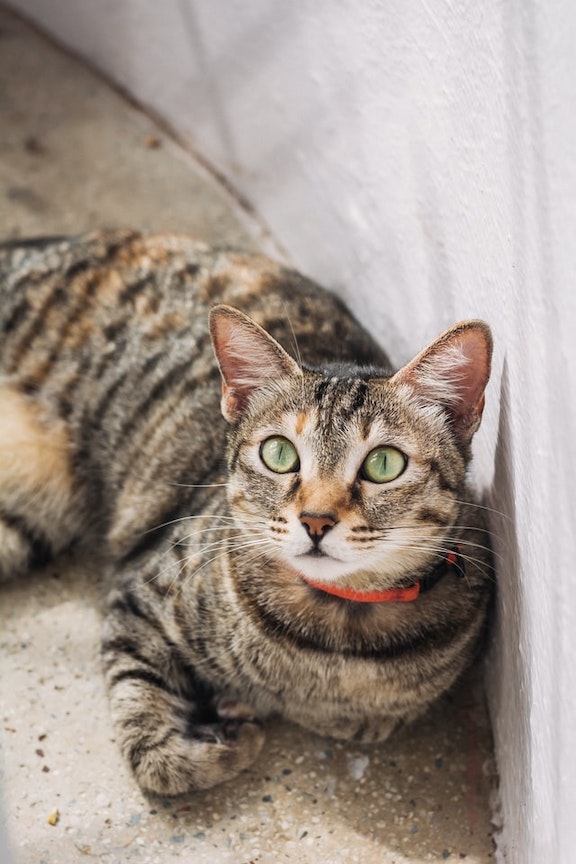The Hidden Dangers of Flea Collars
Posted: 11/06/2023 | BY: Erin Cain | Categories: Uncategorized
Flea collars have long been a highly accessible and inexpensive way for pet parents to protect their dog or cat from this invasive and hard-to-shake parasite. Unfortunately, recent events involving Seresto flea collars have proven that these collars are dangerous and deadly to pets — and pet parents. If you have a flea collar for your pet, you may not realize the potential harm it can do. Here are the hidden dangers of flea collars and why you may want to find an alternative flea control for your best furry friend.

How do flea collars work?
Flea collars are one of the most popular methods of preventing and treating fleas in cats and dogs. The collars work by releasing pesticides onto your pet’s skin or giving off harmful gases over time. Some flea collars, like the Seresto model, work for up to eight months. Many pet parents favored this form of pest control because of its affordability — collars range from $5 – $60 — as opposed to flea dips or oral pest preventative medications, which are more costly over time.
Why are flea collars dangerous?
If flea collars are so popular, how can they be dangerous to pets? The chemicals in the collars, and the residue left behind on our pets, are where the threat lies.
For example, the Seresto collars contain 4.5% flumethrin, a synthetic pyrethroid insecticide, and 10% imidacloprid, an insecticide that mimics nicotine. A recent study by the National Resources Defense Council (NRDC) found that not only were these insecticides potentially harmful to pets, but they also endangered both adults and children who play with or sleep in the same bed as their pets.
A deadly combination
One possible theory as to why the residue is so dangerous is the combination of these two insecticides. Bayer, the company that began selling Seresto collars in 2012, found that combining these insecticides created a “synergistic effect,” providing a higher level of toxicity; thus, a more successful and profitable flea collar. Seresto flea collars earned Bayer $300 million in 2019 before Bayer sold the product to Elanco Animal Health for $7.6 billion and shares of Elanco stock.
Toxic insecticides exposure
Toxic insecticides are not limited to the Seresto collars; many other flea collar brands contain flumethrin and imidacloprid. Some companies use other insecticides such as tetrachlorvinphos (TCVP), an organophosphate pesticide toxic to the nervous system, or propoxur, a carcinogen that causes cancer. The NRDC study found that after three days of dogs wearing a flea collar with these insecticides, 50% had enough residue on their fur to pose severe neurological risks and cancer risks to young children and pregnant women.
Additionally, the NRDC research shows that the insecticide propoxur contaminates the air in your home and can be inhaled, ingested, or absorbed through the skin through contact with your pet.

Recent flea collar controversy
The dangers of flea collars have become more well known due to the recent controversy surrounding the Seresto flea collars and the Environmental Protection Agency’s reluctance to inform the public of these health risks. The continued inaction on the part of the EPA is surprising considering their recent research documents on the Seresto collar insecticides show that the product has the highest incidences of injury to pets and humans and fatalities amongst both dogs and cats.
There have been 75,000 incident reports of pet and human health problems and nearly 1,700 pet deaths associated with the Seresto flea collars. The most common reaction before pets’ deaths was a sudden seizure followed by cardiac arrest.
A range of unhealthy effects
The impact on dogs and cats who wear flea collars ranges from uncomfortable, such as allergic reactions, to deadly fatalities that happen suddenly and with little warning. Some veterinarians still advocate using flea collars, claiming that serious incidents are rare and that most pets who have adverse reactions develop rashes or experience vomiting or diarrhea. That is cold comfort to those pet parents whose pets have had severe reactions or have died due to their exposure to the insecticides in their flea collars.
Despite the EPA and some veterinarians’ claims, it doesn’t appear safe to have insecticides on your pet, your pet’s fur, your children, your home, and yourself.
What are safe alternatives to flea collars?
There are a variety of pet and child-safe, all-natural, and environmentally friendly alternatives to flea collars. Some natural methods to consider include:
- Apple cider vinegar is an excellent flea preventative, though it won’t help if your pet already has fleas. Bathe your pet with it, add it to her water or food, or make some homemade flea repellent by mixing 1 part water to 1 part apple cider vinegar.
- Diatomaceous earth consists of naturally occurring powdered mineral substances. When spread around the home, it works to minimize and prevent fleas from entering the environment. Unless instructed by your veterinarian, never apply diatomaceous earth directly to your pets as they may experience severe skin irritation.
- Essential oils may also help limit or eliminate flea infestations in and outside of your home. Oils such as cedar, cedarwood, clove, lavender, lemongrass, rosemary, rose geranium, and peppermint are frequently used to control and prevent fleas. Never spray these oils directly on your pet, and only use diluted drops with your veterinarian’s knowledge.
There are also several oral flea preventatives that you can purchase directly from your veterinarian or online pet stores with a veterinary prescription. Whichever route you choose, always discuss your decision with a veterinarian before treating your pet for fleas.
Pet insurance helps when the unexpected happens.
We always try to do what’s best for our pets, but sometimes what we think is right turns out to be wrong and maybe even deadly. When the unexpected happens, it helps to have all the support you can find. A pet insurance policy provides coverage of most of your emergency veterinary costs, so you don’t have to worry about finances and can focus on what is most important: your pet.
Get a free pet insurance quote today through Pet Insurance Review, so you and your furkid are protected and prepared for whatever tomorrow brings.
References:
- Wehner, M. (2021). These pet collars have been linked to nearly 2,000 pet deaths. Retrieved from https://bgr.com/science/seresto-collar-dangerous-health-effects-5910699/
- Tick Repellant Guide. (2021). What Is Flumethrin And How Does It Work? Retrieved from https://tickrepellent.net/what-is-flumethrin-and-how-does-it-work/
- National Pesticide Information Center. (2010). Imidacloprid General Fact Sheet. Retrieved from http://npic.orst.edu/factsheets/imidagen.html
- Rotkin-Ellman, M., Solomon, G., Minjares, M., Epstein, H. (2009). Poison on Pets II: Toxic Chemicals in Flea and Tick Collars. Retrieved from https://www.nrdc.org/sites/default/files/poisonsonpets.pdf
- Wehner, M. (2021). These pet collars have been linked to nearly 2,000 pet deaths. Retrieved from https://bgr.com/science/seresto-collar-dangerous-health-effects-5910699/
- Carter, M. (2015). The 5 Most Toxic Items at Pet Stores. Retrieved from https://www.womansday.com/life/pet-care/g1918/the-most-toxic-items-at-pet-stores/
- Hettinger, J. (2021). Popular flea collar linked to almost 1,700 pet deaths. The EPA has issued no warning. Retrieved from https://www.usatoday.com/story/news/investigations/2021/03/02/seresto-dog-cat-collars-found-harm-pets-humans-epa-records-show/4574753001/
- Kawczynska, C. (2021). Is Seresto Flea & Tick Collar Unsafe for Dogs? Retrieved from https://thebark.com/content/seresto-flea-tick-collar-unsafe-dogs
- Environmental Protection Agency. (2020). Aggregate Incident Summary Report for EPA Reg No 11556-155 1-1-2012 to 6-16-2020. Retrieved from https://www.documentcloud.org/documents/20473296-aggregate-incident-summary-report-for-epa-reg-no-11556-155-1-1-2012-to-6-16-2020
- Rotkin-Ellman, M., Solomon, G., Minjares, M., Epstein, H. (2009). Poison on Pets II: Toxic Chemicals in Flea and Tick Collars. Retrieved from https://www.nrdc.org/sites/default/files/poisonsonpets.pdf
- Rosenberg, K. (2021). Investigation begins into Seresto flea collar death allegations. Retrieved from https://www.petsradar.com/news/vets-call-for-calm-over-seresto-flea-collar-death-allegations
- Cima, G. (2021). Seresto collars come under greater scrutiny. Retrieved from https://www.avma.org/javma-news/2021-05-01/seresto-collars-come-under-greater-scrutiny
- Hettinger, J. (2021). Popular flea collar linked to almost 1,700 pet deaths. The EPA has issued no warning. Retrieved from https://www.usatoday.com/story/news/investigations/2021/03/02/seresto-dog-cat-collars-found-harm-pets-humans-epa-records-show/4574753001/
- Osmanski, S. (2019). Here’s How to Treat Fleas — the All-Natural Way. Retrieved from https://www.greenmatters.com/p/all-natural-flea-treatment
- Stregowski, J. (2021). Diatomaceous Earth for Flea Control. Retrieved from https://www.thesprucepets.com/diatomaceous-earth-for-flea-control-3385244
- Public Goods. (2019). What Essential Oils Kill Fleas? Retrieved from https://blog.publicgoods.com/what-essential-oils-kill-fleas/
- Burke, A. (2020). Flea Pills for Dogs. Retrieved from https://www.akc.org/expert-advice/health/flea-pills-dogs/
Disclaimer
The information contained on this blog is intended for informational and educational purposes only and should not be construed as medical advice. It is not a substitute for professional veterinary care. Always consult with your veterinarian before making any changes to your pet's health care or treatment plan.
The authors of this blog are not veterinarians and do not claim to be experts in pet health. The information provided here is based on our own experiences and research, as well as information from reputable sources. However, we cannot guarantee the accuracy or completeness of this information.
We encourage you to do your own research and consult with your veterinarian before making any decisions about your pet's health.
Previous post
Common Cancers in CatsCompare top pet insurance providers plans.
Enter your dog’s age in years and months to calculate their age equivalent to human years.
Calculate your dog’s ageEnter your cat’s age in years and months to calculate their age equivalent to human years.
Calculate your cat’s age